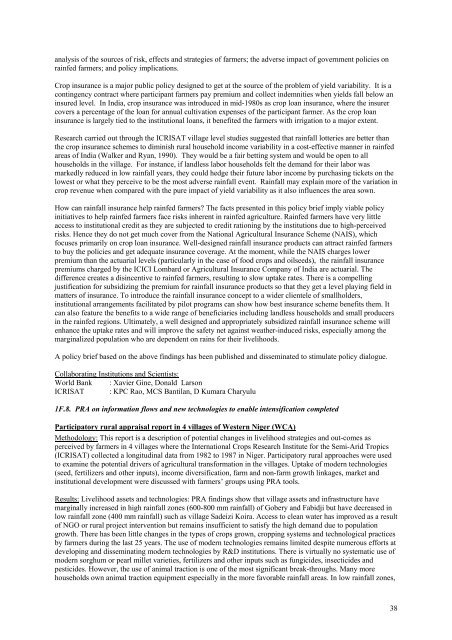ICRISAT Archival Report 2006 - The seedlings of success in the ...
ICRISAT Archival Report 2006 - The seedlings of success in the ...
ICRISAT Archival Report 2006 - The seedlings of success in the ...
You also want an ePaper? Increase the reach of your titles
YUMPU automatically turns print PDFs into web optimized ePapers that Google loves.
analysis <strong>of</strong> <strong>the</strong> sources <strong>of</strong> risk, effects and strategies <strong>of</strong> farmers; <strong>the</strong> adverse impact <strong>of</strong> government policies on<br />
ra<strong>in</strong>fed farmers; and policy implications.<br />
Crop <strong>in</strong>surance is a major public policy designed to get at <strong>the</strong> source <strong>of</strong> <strong>the</strong> problem <strong>of</strong> yield variability. It is a<br />
cont<strong>in</strong>gency contract where participant farmers pay premium and collect <strong>in</strong>demnities when yields fall below an<br />
<strong>in</strong>sured level. In India, crop <strong>in</strong>surance was <strong>in</strong>troduced <strong>in</strong> mid-1980s as crop loan <strong>in</strong>surance, where <strong>the</strong> <strong>in</strong>surer<br />
covers a percentage <strong>of</strong> <strong>the</strong> loan for annual cultivation expenses <strong>of</strong> <strong>the</strong> participant farmer. As <strong>the</strong> crop loan<br />
<strong>in</strong>surance is largely tied to <strong>the</strong> <strong>in</strong>stitutional loans, it benefited <strong>the</strong> farmers with irrigation to a major extent.<br />
Research carried out through <strong>the</strong> <strong>ICRISAT</strong> village level studies suggested that ra<strong>in</strong>fall lotteries are better than<br />
<strong>the</strong> crop <strong>in</strong>surance schemes to dim<strong>in</strong>ish rural household <strong>in</strong>come variability <strong>in</strong> a cost-effective manner <strong>in</strong> ra<strong>in</strong>fed<br />
areas <strong>of</strong> India (Walker and Ryan, 1990). <strong>The</strong>y would be a fair bett<strong>in</strong>g system and would be open to all<br />
households <strong>in</strong> <strong>the</strong> village. For <strong>in</strong>stance, if landless labor households felt <strong>the</strong> demand for <strong>the</strong>ir labor was<br />
markedly reduced <strong>in</strong> low ra<strong>in</strong>fall years, <strong>the</strong>y could hedge <strong>the</strong>ir future labor <strong>in</strong>come by purchas<strong>in</strong>g tickets on <strong>the</strong><br />
lowest or what <strong>the</strong>y perceive to be <strong>the</strong> most adverse ra<strong>in</strong>fall event. Ra<strong>in</strong>fall may expla<strong>in</strong> more <strong>of</strong> <strong>the</strong> variation <strong>in</strong><br />
crop revenue when compared with <strong>the</strong> pure impact <strong>of</strong> yield variability as it also <strong>in</strong>fluences <strong>the</strong> area sown.<br />
How can ra<strong>in</strong>fall <strong>in</strong>surance help ra<strong>in</strong>fed farmers? <strong>The</strong> facts presented <strong>in</strong> this policy brief imply viable policy<br />
<strong>in</strong>itiatives to help ra<strong>in</strong>fed farmers face risks <strong>in</strong>herent <strong>in</strong> ra<strong>in</strong>fed agriculture. Ra<strong>in</strong>fed farmers have very little<br />
access to <strong>in</strong>stitutional credit as <strong>the</strong>y are subjected to credit ration<strong>in</strong>g by <strong>the</strong> <strong>in</strong>stitutions due to high-perceived<br />
risks. Hence <strong>the</strong>y do not get much cover from <strong>the</strong> National Agricultural Insurance Scheme (NAIS), which<br />
focuses primarily on crop loan <strong>in</strong>surance. Well-designed ra<strong>in</strong>fall <strong>in</strong>surance products can attract ra<strong>in</strong>fed farmers<br />
to buy <strong>the</strong> policies and get adequate <strong>in</strong>surance coverage. At <strong>the</strong> moment, while <strong>the</strong> NAIS charges lower<br />
premium than <strong>the</strong> actuarial levels (particularly <strong>in</strong> <strong>the</strong> case <strong>of</strong> food crops and oilseeds), <strong>the</strong> ra<strong>in</strong>fall <strong>in</strong>surance<br />
premiums charged by <strong>the</strong> ICICI Lombard or Agricultural Insurance Company <strong>of</strong> India are actuarial. <strong>The</strong><br />
difference creates a dis<strong>in</strong>centive to ra<strong>in</strong>fed farmers, result<strong>in</strong>g to slow uptake rates. <strong>The</strong>re is a compell<strong>in</strong>g<br />
justification for subsidiz<strong>in</strong>g <strong>the</strong> premium for ra<strong>in</strong>fall <strong>in</strong>surance products so that <strong>the</strong>y get a level play<strong>in</strong>g field <strong>in</strong><br />
matters <strong>of</strong> <strong>in</strong>surance. To <strong>in</strong>troduce <strong>the</strong> ra<strong>in</strong>fall <strong>in</strong>surance concept to a wider clientele <strong>of</strong> smallholders,<br />
<strong>in</strong>stitutional arrangements facilitated by pilot programs can show how best <strong>in</strong>surance scheme benefits <strong>the</strong>m. It<br />
can also feature <strong>the</strong> benefits to a wide range <strong>of</strong> beneficiaries <strong>in</strong>clud<strong>in</strong>g landless households and small producers<br />
<strong>in</strong> <strong>the</strong> ra<strong>in</strong>fed regions. Ultimately, a well designed and appropriately subsidized ra<strong>in</strong>fall <strong>in</strong>surance scheme will<br />
enhance <strong>the</strong> uptake rates and will improve <strong>the</strong> safety net aga<strong>in</strong>st wea<strong>the</strong>r-<strong>in</strong>duced risks, especially among <strong>the</strong><br />
marg<strong>in</strong>alized population who are dependent on ra<strong>in</strong>s for <strong>the</strong>ir livelihoods.<br />
A policy brief based on <strong>the</strong> above f<strong>in</strong>d<strong>in</strong>gs has been published and dissem<strong>in</strong>ated to stimulate policy dialogue.<br />
Collaborat<strong>in</strong>g Institutions and Scientists:<br />
World Bank : Xavier G<strong>in</strong>e, Donald Larson<br />
<strong>ICRISAT</strong> : KPC Rao, MCS Bantilan, D Kumara Charyulu<br />
1F.8. PRA on <strong>in</strong>formation flows and new technologies to enable <strong>in</strong>tensification completed<br />
Participatory rural appraisal report <strong>in</strong> 4 villages <strong>of</strong> Western Niger (WCA)<br />
Methodology: This report is a description <strong>of</strong> potential changes <strong>in</strong> livelihood strategies and out-comes as<br />
perceived by farmers <strong>in</strong> 4 villages where <strong>the</strong> International Crops Research Institute for <strong>the</strong> Semi-Arid Tropics<br />
(<strong>ICRISAT</strong>) collected a longitud<strong>in</strong>al data from 1982 to 1987 <strong>in</strong> Niger. Participatory rural approaches were used<br />
to exam<strong>in</strong>e <strong>the</strong> potential drivers <strong>of</strong> agricultural transformation <strong>in</strong> <strong>the</strong> villages. Uptake <strong>of</strong> modern technologies<br />
(seed, fertilizers and o<strong>the</strong>r <strong>in</strong>puts), <strong>in</strong>come diversification, farm and non-farm growth l<strong>in</strong>kages, market and<br />
<strong>in</strong>stitutional development were discussed with farmers’ groups us<strong>in</strong>g PRA tools.<br />
Results: Livelihood assets and technologies: PRA f<strong>in</strong>d<strong>in</strong>gs show that village assets and <strong>in</strong>frastructure have<br />
marg<strong>in</strong>ally <strong>in</strong>creased <strong>in</strong> high ra<strong>in</strong>fall zones (600-800 mm ra<strong>in</strong>fall) <strong>of</strong> Gobery and Fabidji but have decreased <strong>in</strong><br />
low ra<strong>in</strong>fall zone (400 mm ra<strong>in</strong>fall) such as village Sadeizi Koira. Access to clean water has improved as a result<br />
<strong>of</strong> NGO or rural project <strong>in</strong>tervention but rema<strong>in</strong>s <strong>in</strong>sufficient to satisfy <strong>the</strong> high demand due to population<br />
growth. <strong>The</strong>re has been little changes <strong>in</strong> <strong>the</strong> types <strong>of</strong> crops grown, cropp<strong>in</strong>g systems and technological practices<br />
by farmers dur<strong>in</strong>g <strong>the</strong> last 25 years. <strong>The</strong> use <strong>of</strong> modern technologies rema<strong>in</strong>s limited despite numerous efforts at<br />
develop<strong>in</strong>g and dissem<strong>in</strong>at<strong>in</strong>g modern technologies by R&D <strong>in</strong>stitutions. <strong>The</strong>re is virtually no systematic use <strong>of</strong><br />
modern sorghum or pearl millet varieties, fertilizers and o<strong>the</strong>r <strong>in</strong>puts such as fungicides, <strong>in</strong>secticides and<br />
pesticides. However, <strong>the</strong> use <strong>of</strong> animal traction is one <strong>of</strong> <strong>the</strong> most significant break-throughs. Many more<br />
households own animal traction equipment especially <strong>in</strong> <strong>the</strong> more favorable ra<strong>in</strong>fall areas. In low ra<strong>in</strong>fall zones,<br />
38

















